
Cassava Pest and Disease Control
October 1, 2023, 4:07 pm
The first line of defence against cassava pests and diseases is a healthy agro-ecosystem because synthetic insecticide, fungicide and herbicide disrupt the natural crop ecosystem balance.
“Save and Grow” seeks to minimize their use to the extent possible. It promotes instead integrated pest management (or IPM), a crop protection strategy that aims at enhancing the biological processes and crop-associated biodiversity that underpin production.
Crop losses to insects are kept to an acceptable minimum by deploying resistant varieties, conserving and encouraging biological control agents, and managing crop nutrient levels to reduce insect reproduction. Diseases are controlled through the use of clean planting material, crop rotations to suppress pathogens, and elimination of infected host plants. Effective weed management entails timely manual weeding and the use of surface mulches to suppress weed growth.
When necessary, low-risk selective pesticides may be used for targeted control, in the right quantity and at the right time. Since all pesticides are potentially toxic to people and the environment, the products employed must be locally registered and approved, and carry clear instructions on their safe handling and use.
Like all major crops, cassava is vulnerable to pests and diseases that can cause heavy yield losses. Their impact is most serious in Africa. Until recently, Asia had few serious pest and disease problems, but this may be changing as the crop is grown more intensively over larger areas and planted throughout the year for industrial processing.
When pest or disease management measures become necessary, a strategy of non-chemical control should be considered before any decision is taken to use pesticide. Since cassava is a long-season crop, and exposed to pests and diseases for an extended period, pesticide is usually ineffective and hardly ever economic. That is why insecticide, for example, should be used only in short-term, localized applications in “hot spots” where the pest is first observed, and only when the pest is in its early stage of development.
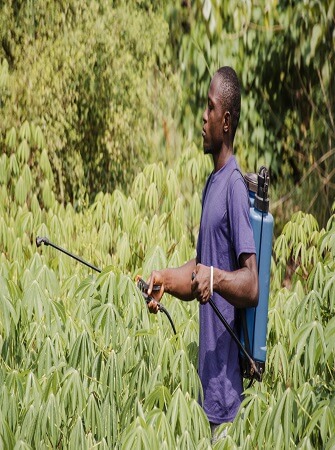
A range of non-chemical measures can help farmers reduce losses to pests and diseases while protecting the agro-ecosystem. First, planting material should be of varieties with tolerance or resistance to the most important cassava diseases and pests, and taken from mother plants that are free of disease symptoms and signs of pest attacks. As an extra precaution, stakes can be soaked in hot water to kill pests or disease-causing organisms that might be present.
In extreme cases, soaking stakes in a solution of fungicide and insecticide may be necessary. However, farmers who do so must have received training in the correct use of pesticide and, in selecting chemicals, should follow the recommendations of local plant protection specialists.
Ecosystem-based practices, such as mulching, planting hedges and intercropping, can provide refuges for natural enemies of insect pests. Building up soil organic matter increases pest-regulating populations early in the cropping cycle.
During crop growth, applying adequate amounts of mineral fertilizer or manure to the crop can enhance its resistance or tolerance. Insecticide should not be applied to the leaves of the growing cassava plant, as it may kill natural biological control agents that help to keep some major pests and diseases under control. For example, insecticide kills cassava mites’ natural enemies – phytoseiid mite predators – before killing the mites themselves. When natural predators are eliminated, the result is an increase in the pest population, to which farmers may respond with increased use of pesticide, thereby perpetuating and worsening the cycle of pest damage.
Biopesticides, such as extract of neem seed oil, are recommended for controlling whiteflies, mealybugs and variegated grasshoppers. Whitefly and mealybug numbers can also be reduced with sticky traps and by spraying plants with soapy water.
Control of Major Cassava Diseases
Although the largest number of cassava diseases is found in Latin America and the Caribbean, the plant’s centre of origin, many of them are now also found in sub-Saharan Africa and Asia. Some have evolved separately in Africa and Asia, and have not yet arrived in the Americas.
Bacterial blight is one of the most widespread and serious of the cassava diseases. Caused by the proteobacterium Xanthomonas axonopodis pv. manihotis, it is transmitted mainly by infected planting material or infected farm tools. It can also be spread from one plant to another by rain splash, and by the movement of people, machines or animals from infected fields to healthy fields. The bacterium infects first the leaves, which turn brown in large patches and eventually die, then the vascular tissues of the petioles and woody stems.
The effect of bacterial blight on yields varies according to factors such as location, variety, weather patterns, planting time and the quality of planting material. In 1974, the disease caused losses of 50 percent in large plantations in Brazil. Bacterial blight can also threaten food security by reducing the production of cassava leaves, which are an important source of vegetable protein in Central Africa.
Although potentially devastating, bacterial blight can be controlled effectively with “Save and Grow” practices. They include:
1. Use varieties with good tolerance (many tolerant, high-yielding varieties are now available)
2. Use healthy planting material from disease-free plants or plants derived from meristem culture, rooted buds or shoots
3. Before planting, treat stakes by soaking them in hot water at 50°C for about 50 minutes. In extreme cases, and on the advice of local plant protection specialists, stakes may be soaked for 10 minutes in a solution of cupric fungicides
4. Plant at the end of rainy periods
5. After using tools in blight-infected plots, sterilize them in hot water or in a dilute solution of a disinfectant, such as sodium hypochlorite
6. Ensure that the plants are adequately fertilized, especially with potassium
7. Uproot and burn any diseased plants and infected crop residues
8. Intercrop cassava with other species to reduce plant-to-plant dissemination of bacterial blight caused by rain-splash (fast growing crops such as maize will also reduce dissemination by wind)
9. To prevent the carry-over of the disease in the soil, rotate cassava with other crops, or leave the field in fallow for at least six months between cassava crops.
Viral diseases are usually transmitted through the use of infected planting material. In addition, whiteflies – mainly of the species Bemisia tabaci – are vectors for viruses that cause cassava mosaic disease (CMD) and cassava brown streak disease (CBSD).
Cassava mosaic disease is endemic in sub-Saharan Africa. Common symptoms include misshapen leaves, chlorosis, mottling and mosaic. Plants suffer stunting and general decline, and the more severe the symptoms, the lower the root yield. In the mid-1990s, an unusually severe form of CMD caused yield losses of 80 to 100% in parts of Kenya and Uganda. CMD is also the most serious cassava disease in India and Sri Lanka, where it can lead to root losses of up to 90% in traditional varieties.
Cassava brown streak disease causes corky necrosis in roots that renders them unfit for consumption. The disease has been responsible for total crop failures in parts of Africa’s Great Lakes region. In 2011, FAO warned that none of the cassava varieties grown by farmers in the region seemed to be resistant to CBSD. Even plants produced from clean planting material can become infected through the transmission of the virus by B. tabaci whiteflies from infected plants in neighbouring plots. Because the symptoms of CBSD may not be evident on the cassava leaves or stems, farmers may not be aware that their crops are infected until they harvest the roots. The lack of above-ground symptoms makes the use of disease-infected planting material more likely.
Two key recommendations for control of both CMD and CBSD are strict enforcement of quarantine procedures during international exchange of cassava germplasm, and cultural practices, especially the use of resistant or tolerant cultivars and virus-free planting material. A major effort has been made to produce and distribute CMD- and CBSD-free planting material in the Great Lakes region. January 2012 saw the release in the United Republic of Tanzania of four highyielding cassava varieties, bred through marker-assisted selection, that are resistant to CMD and tolerant to CBSD.
A decade of intensive research at Kerala’s Central Tuber Crops Research Institute identified a Nigerian variety and the wild species, Manihot caerulescens, as resistant to both the Indian and Sri Lankan mosaic viruses. Researchers have used those two donor parents and crossed them with high-yielding local varieties to produce several promising lines resistant to CMD, one of which has become popular in the industrial cassava belts of Tamil Nadu.
Root rots occur mainly in poorly drained soils during very intense rainy periods, and are common in Africa, Asia and Latin America. They are caused by a wide range of fungal and bacterial pathogens and lead to loss of leaves, dieback in stems and shoots, and root deterioration, either as the crop grows or during post-harvest storage.
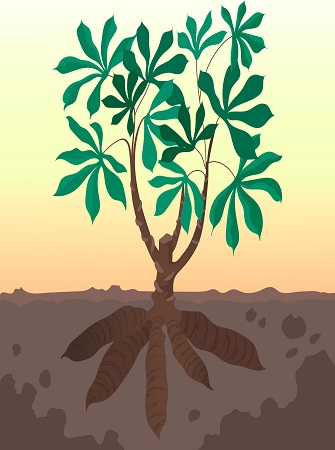
Farm tools and plant residues left in fields post-harvest are often contaminated with disease-causing fungi and are sources of spores that infect new plants. In trials in Colombia’s Amazon region, smallholder farmers eliminated cassava root rot using simple “Save and Grow” practices. They planted stakes taken only from healthy mother plants, used a mixture of ashes and dry leaves as a soil amendment and fertilizer during planting, and intercropped cassava with cowpeas.
Other cultural practices that control root rots include:
1. If no disease-free planting material is available, immerse stakes in hot water for around 50 minutes
2. Plant on light-textured, moderately deep soils with good internal drainage
3. Improve drainage by reducing tillage and using surface mulches
4. Rotate cassava with cereals or grasses
5. Uproot and burn diseased plants
An effective biological control for root rot is immersion of the stakes in a suspension of Trichoderma viride, a fast-growing species of soil fungus that parasitizes the vegetative tissue of other soil-borne fungi. In experiments in Nigeria, two groups of stored cassava roots were inoculated with four pathogenic fungi. One group was also inoculated with a culture filtrate of T. viride. Over a period of three weeks, the group without T. viride suffered an incidence of rot ranging from 20 to 44%; in the group inoculated with the biocontrol agent, there was a drastic reduction in the range and number of the target fungi, with the incidence of rot ranging from zero to 3 percent after three weeks. Inoculation with T. viride rendered unnecessary repeated spraying with synthetic fungicide
Control of Major Cassava Insect Pests
Around 200 species of arthropod pests have been reported on cassava. Of these, some are specific to the crop, while others attack other crops as well. The greatest diversity of cassava insect pests is found in Latin America, where they have co-evolved with the crop. However, cassava pest problems are not necessarily more serious in Latin America – many harmful insects are kept under control by predators and parasitoids, which have co-evolved over the centuries.
Whiteflies feed directly on young cassava leaves and are also a virus vector, making them probably the most damaging insect pest in all cassava-producing regions. In Latin America, 11 whitefly species have been reported on cassava, including Aleurotrachelus socialis, A. aepim and Trialeurodes variabilis, which cause most damage. The whitefly Bemisia tabaci, the vector of cassava mosaic disease and cassava brown streak disease, is found in most of sub-Saharan Africa and now in India. It is also present in Latin America, but does not feed oncassava. Another species, Aleurodicus disperses, or spiralling whitefly, is found in India, Lao PDR and Thailand, as well as in Africa, and can cause serious damage and yield losses.
Although many farmers use insecticides to control whitefly infestations, spraying is usually ineffective – A. socialis whiteflies, for example, double their numbers in less than five days. Not spraying insecticide, on the other hand, allows biological control by the whitefly’s natural enemies, which include many species of parasitoids, predators and entomopathogens.
A two-year experiment in Cameroon found that intercropping cassava with maize and cowpeas was associated with a drop of 50% in the adult whitefly population and a 20% reduction in the incidence of cassava mosaic disease
Research in Colombia suggests that intercropping with cowpeas depresses cassava leaf growth, making the plant less appetizing to whiteflies. Less vigorous growth did not affect root yields – in fact, yield losses were only 13% in the cassava/cowpea system, but as high as 65% in the monoculture.
Other recommended control measures include imposing a “closed season”, when no cassava can be present in the field, in order to break the whitefly’s development cycle (although, this may not be as effective with some species, such as B. tabaci, that have multiple hosts). Recent trials in Colombia indicate that planting different cassava varieties in the same field may reduce herbivore load and increase yields in zones subject to heavy T. variabilis attacks.
Mealybugs feed on cassava stems, petioles and leaves, and inject a toxin that causes leaf curling, slow shoot growth and eventual leaf withering. Yield loss in infested plants can be up to 60 percent of the roots and 100% of the leaves. Of the approximately 15 species of mealybug that attack cassava plants, two – Phenacoccus herrini and P. manihoti – cause major damage to cassava in Latin America.
In the early 1970s, P. manihoti was accidentally introduced into sub-Saharan Africa, where it had no natural enemies, and spread rapidly throughout the region’s cassava growing areas. The mealybug population was brought under control by the introduction of several natural enemies from South America. The most effective predator was Anagyrus lopezi, a tiny wasp: the female wasp lays its eggs in the mealybug and the growing larvae kill their host.
P. manihoti was recently introduced inadvertently into Thailand and within a year it had spread throughout the country. At its peak, in May 2009, it affected 230,000 ha of Thai cassava-growing land. The outbreak devastated the 2010 cassava harvest, which fell to 22.7 million tonnes, from a record of 30 million tonnes the year before. How Thai authorities and farmers responded to the 2009 mealybug outbreak provides an excellent example of the effectiveness of biological pest control. To avoid new outbreaks, farmers were advised not to plant cassava in the late rainy season and early dry season, and to soak stakes in an insecticide solution before planting.
They were also warned to avoid spraying insecticides on the plants themselves – experience had shown that spraying provoked the pest’s resurgence. To control outbreaks, researchers identified several native predators and parasites but concluded they were unable to effectively reduce the mealybug population. They suggested the use of Anagyrus lopezi, the wasp that had successfully controlled the mealybug in Africa in the 1970s. In September 2009, some 500 adults of A. lopezi were handcarried to Bangkok from IITA’s Biological Control Centre in Benin.
After quarantine laboratory tests and field trials, the government began large-scale multiplication and distribution of the wasp. By May 2012, almost 3 million pairs of A. lopezi had been released throughout the infested cassava area. The biological control campaign was highly successful – the infested area was reduced to 170,000 ha in 2010, to 64,000 ha in 2011 and just 3,300 ha in 2012.
Current recommendations for the control of cassava mealybugs include:
1. Conserve the population of natural enemies by not spraying synthetic pesticide
2. If necessary, treat planting material with a solution using a locally registered and recommended insecticide
3. Monitor cassava plantations every 2 to 4 weeks to detect focal points of infestation
4. Remove and burn the infested parts of plants
5. Avoid the movement of planting material from one region to another
6. Minimize the movement of planting material from infested to non-infested fields
Cassava mites are an important insect pest in all producing regions. The cassava green mite, Mononychellus tanajoa, causes the most damage to cassava in Latin America and sub-Saharan Africa, especially in lowland areas with a prolonged dry season. It feeds on the underside of young leaves, which become white-yellow, deformed and smaller. The mite can cause root yield losses of up to 80 percent. Another green mite species, M. mcgregori, was recently reported in Cambodia, China and Viet Nam. Although it may not be as aggressive as M.tanajoa, it could cause serious damage owing to the lack of primary natural enemies.
The introduction of green mites on cassava imported from Latin America in the early 1970s devastated Africa’s cassava production. To bring the mite under control, entomologists at IITA and CIAT first identified its area of origin in South America and its natural enemy, another mite, from Brazil. The Brazilian mites survived in Africa but their diffusion was very slow.
The solution was another predatory mite, Tetranychus aripo, which spread rapidly in African farmer’s fields and did not have a voracious appetite for green mites – an advantage, since it allows enough green mites to survive and prevent the predatory mites from dying out. As well as reducing the damage caused by green mites throughout Africa, T. aripo has contributed substantially to the science of biological control and to the knowledge of how mites work in complex food systems.
Many species of red spider mites have been observed on cassava in all three cassava-producing regions. It is the most prevalent dry season pest of cassava in Asia, where the most common species are Tetranychus urticae and T. kanzawai. Yield losses range from 18 to almost 50%. Red mites feed mainly on the underside of leaves, but attack old leaves at the base of the plant, causing considerable webbing. Further research is urgently needed to identify the most effective natural enemies of red spider mites.
Current recommendations for the control of cassava mites include:
1. Plant resistant or tolerant varieties, if available
2. In endemic areas, treat stakes with a recommended, locally approved insecticide
3. Promote good establishment by planting early in the wet season
4. Apply adequate and well-balanced fertilizers to improve plant vigour
5. Apply foliar sprays with water at high pressure to reduce mite populations
6. Strictly enforce quarantine regulations
Cassava Weed Management
Compared to many other crops, the initial growth of cassava is slow. That, combined with the wide spacing between planted stakes, gives weeds a chance to emerge and compete for sunlight, water and nutrients. In the first four months after planting, cassava can easily be overwhelmed by competition from narrow-leaf grassy weeds and from broad-leaf weeds, which include many leguminous plants. In East Africa, weeds are often a more serious production constraint than insect pests or diseases and can reduce yields by about 50%.
In Nigeria, farmers spend more time on weeding than on any other aspect of crop production. Once the cassava canopy has closed, it will shade out most weeds and keep the field almost completely weed-free. Six to eight months after planting, when cassava starts to shed many leaves (especially during the dry season), weeds may reappear, but this generally does not seriously affect yields. Excessive late weed growth may make harvesting more difficult, but can also protect the soil from erosion if “Save and Grow” cultural practices can provide an effective defence against weeds. While cultural controls may not be 100 percent effective, they do help in reducing weed competition, and thus the need for mechanical or chemical weeding.
Cultural control begins with selection of high-quality planting material from varieties with vigorous early growth and tolerance or resistance to important diseases and pests. High planting density and the correct type and rate of fertilizer, applied in short bands next to the planted stakes, can stimulate early crop growth and rapid canopy closure. Planting in the dry season under drip irrigation can also encourage the growth of cassava but not that of weeds.
To prevent weed emergence, the soil should be covered with a thick layer of mulch, such as rice straw or maize residues. Another “Save and Grow” recommendation is to intercrop cassava with fastgrowing plants, such as melons, squash, pumpkins, common beans, groundnuts, soybeans, mungbeans and cowpeas. As those are short-duration crops, they can be harvested after about 3 to 4 months, when the cassava canopy closes and weeds are shaded out. While intercrops may reduce cassava root yields, they markedly reduce weed growth, and offer an eco-friendly – and less expensive – alternative to spraying with herbicides.
A study in Nigeria of legume cover crops in a mixed cassava/maize system reported significant improvements in cassava root yields when velvet beans were grown to suppress weeds. Many smallholder cassava farmers use mechanical control measures. Most commonly, they remove weeds by hoeing, starting about 15 days after planting, or after emergence if the cassava is planted horizontally.
Weeds growing between the rows can also be incorporated into the soil using an oxen- or buffalo-drawn cultivator or, where available, tractors equipped with cultivator blades.
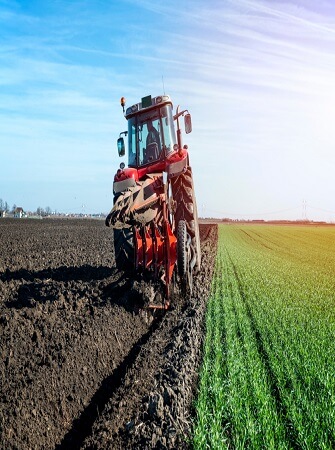
In the absence of both machinery and draught animals, farmers in Thailand use a manually-drawn cultivator, known as a “poor man’s plough”. In Viet Nam, farmers use a contraption made from the handlebar and front wheel of a bicycle, with a cultivator blade attached behind the wheel. This operation is usually followed by hand weeding with a hoe between the plants in the row.
On larger farms or when labour is unavailable or is too expensive, weeds are often controlled with herbicides. Many herbicides are highly toxic and, being water soluble and persistent in the environment, can be washed away to contaminate ground and surface water. Farmers need to exercise care in the choice of the herbicide to be used and follow the advice of local plant protection specialists.
Pre-emergence herbicides do not kill existing weeds. Instead, they prevent weed seeds in the soil from emerging or, at least, reduce their rate of growth. Pre-emergence herbicides are either incorporated into the soil before planting or applied on the soil surface with a knapsack sprayer immediately after planting. Pre-emergence herbicides that are selective for cassava can be applied over the vertically planted stakes without affecting cassava sprouting or yield.
The application of pre-emergence herbicides can maintain a cassava field almost weed-free for 6 to 8 weeks after planting. Farmers ma yapply a mixture of two herbicides – one that controls the grassy weeds and one the broad-leaf weeds. A lower dosage is recommended on light-textured soils, while a higher dosage may be needed in heavy soils, such as loamy clays. Special care needs to be taken when cassava is grown in association with other crops, because the pre-emergence herbicides normally used for cassava may harm the intercrop.
At about two months after planting, weeds may need to be controlled again to reduce competition with cassava. This is usually done by hoeing or using an animal- or tractor-mounted cultivator, depending on the height of the growing cassava plants and the extent of canopy closure.
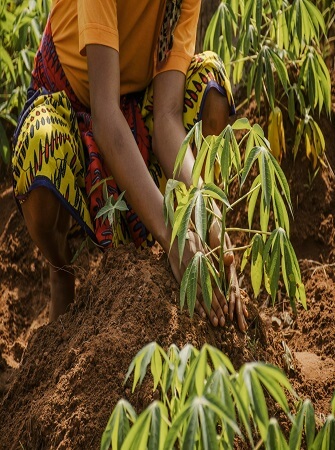
When most of the weeds are grassy species, it is also possible to apply a selective post-emergence herbicide, which kills grasses but does not affect the cassava plant. Post-emergence herbicides can be used about 4 to 5 months after planting, when some bottom leaves start to drop off. They should only be applied on windless days and with a nozzle shield to prevent spray from reaching the cassava stems or leaves.
For more cassava farming information and insights, check our our Cassava Farming resource center. And if you're interested in the business of farming and processing cassava into garri, flour, starch and chips, you can get our cassava farming and processing business plan today.
[Ed.Note: Article references: Food and Agriculture Organization (FAO); International Institute of Tropical Agriculture (IITA)]
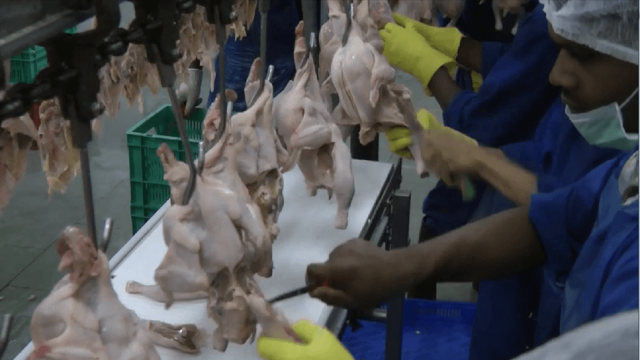
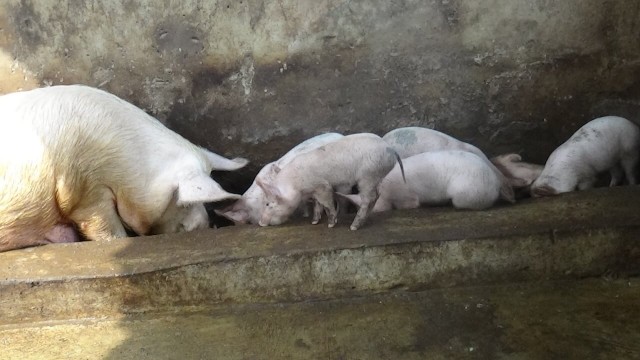
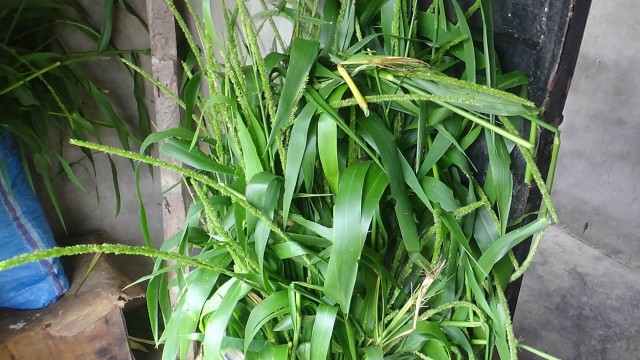
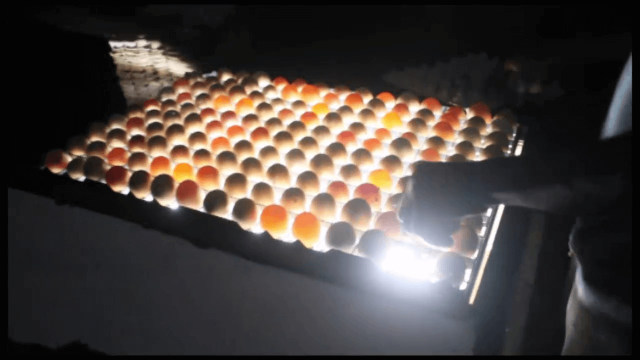

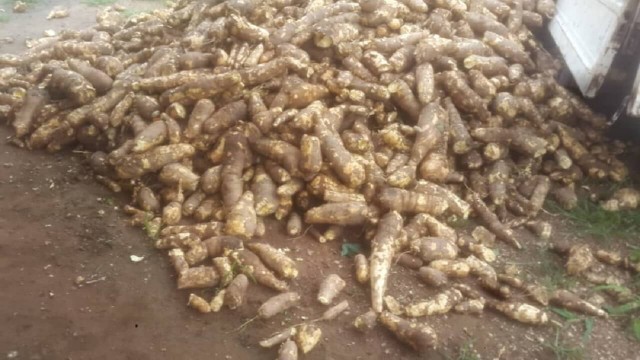
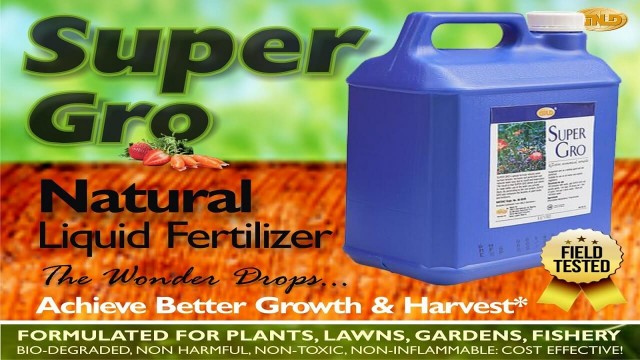
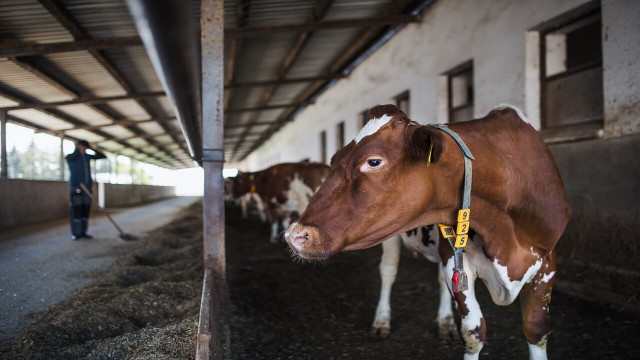

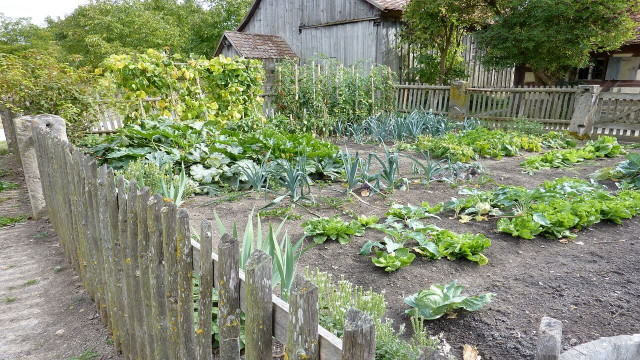


Share This Article: